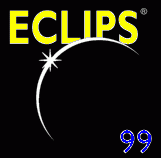 Solar Eclips Experiments Solar Eclips Experiments De  ex ex |
 Solar Eclips Experiments Solar Eclips Experiments De  ex ex |
The UBA (Royal
Union of Belgian RadioAmteurs) and the KMI organised an
experiment to measure how radiowaves are influenced by a solar eclipse. They invited all radioamateurs to
serious take part on this sientific experiment.
This solar eclips happened also in our country and therefor they
had an ideal spot to setup radiobeacons in the total solar eclips
track near Arlon/Virton Belgium.
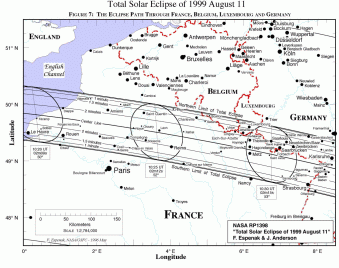
The UBA programmed a special program to be able to make very accurate measurements of the signal/noise ratio of received radiosignals with a PC and a soundcard connected to a receiver. We needed to calibrate the software incoherent with the receiver. In short, we needed to set the measurements in this way that we have a equal readout of the audiosignal gain or attenuation. This ment that if the signal dropped -10dB that the software should measure also a drop of -10dB or visa versa. The normal received signal must be set to -30dB and the noiselevel should be less then -55dB (ideal -60dB) in reference with the received signal that had a frequency of 650Hz. We needed at least one (or more) reference measurement of one of the UBA radiobeacons (ON4UBA/B) near Virton, before the eclipse.
There was a
beacon on HF 80-meters (3,5225 MHz), on the 40-meters (7,0125
MHz) and on 160 meters (1,8315 MHz). I used the 40-meters
radiobeacon for my experiment.
For more information about this experiment in general take a look
at the UBA-website.
As a result, ham
radio operators around the world can track the August
11, 1999 total solar eclipse by monitoring changes in atmospheric
radio
propagation. Also Science@NASA invites ham radio enthusiasts to
submit their data to
help better understand the nature of ionospheric disturbances.
Full story: "http://science.nasa.gov/newhome/headlines/ast04aug99_1.htm"_
I record
measurements on 10/08/99 between 07:00 UTC and 12:30 UTC (14:30
local) and on 11/08/99 between 06:00 UTC and 13:00 UTC
(when beacon has ended it's transmission).
The reference recording the day before and the recording at D-day
itself went well.
Yesterday (10/08/99) I noticed that the signal dropped as time
reached the afternoon and QSB increased (at my location). I
needed to decrease the RF-gain to S3 on my receiver to be able to
calibrate the LF-gain equal to the measurements in the program.
So increasing/decreasing approx 12dB did the same in the program.
There for I needed to build a attenuator of -30dB. But because I
must drop the RF-gain of my receiver to S2...3 to have almost no
AGC control, ment that I did not had much room for very deep
signal drops.
And...indeed the signal of the beacon dropped on the day of the
eclipse starting around +- 10:00 UTC up to about +-11:00 UTC to
noise level. The Eclipse had surely a large effect on the
40-meters beacon signals.
I found the experiment to be one of the most fascinating
activities and most interesting I have ever taken part in at that
time.
I used a Yaesu FRG-100 communications receiver, a homemade
15meters longwire under a 30° angle 9 meters high with a
homemade balun.
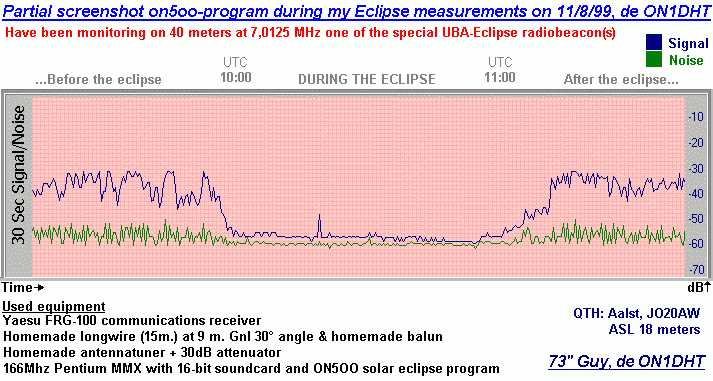
Here are some evaluations of other radioamateurs who joined up for this UBA/KMI experiment:
It was a great
experiance and pleasure to be a part of the great happening.
I was ready to start on 160 m 30 min before eclipse max. here in
Istanbul (95% at 11.16 UTC).
TA1E/0 was on Bozcaada, AS 099 and QRV on 80m SSB. Myself did not
hear any signal on 160 m
11.07 UTC when I
made first QSO with IV3PRK (599/589).
The rest of the LOG: OM5RW, 9A1CCY, SV8CKM, SV8JE, UU4JMG
and the last one was UR5ISQ at11.31UTC.
So, it was an opening of only 25 min. with good signals and a lot
of excitement!
Thanks to all participants and to you John, you did a great job, fellows!
73 Bahri, TA2BK
From GM4BES:
Re: the above
mentioned beacon ... John/ON4UN set up this beacon, operating
from his own QTH and running 600w, as part of a propagation
experiment for
the solar eclipse. There were 2 other similar beacons on 40 and
80 ... These
were only switched on from 0300-1300utc approx for the
experiment.
F.Y.I. ... here the eclipse was only 85%, whereas in Cornwall and
GU/GJ it
was total, Wx here was totally overcast, but I was more
interested in
monitoring 160m!! ... A TRULY FASCINATING experience it was too!
...Propagation was HIGHLY enhanced across the line of shadow ...
Here EA3JE
in Barcelona, southern Spain was 20db over S9 at 1017utc, and
gave me 599
(ere just 100w!) ...
IV3PRK peaked 599+10, and best heard but not worked was a 9A1 ...
The
propagation to the east, i.e. along the track of the eclipse, was
much
poorer, with stations in SP and DJ working IV3PRK, but were not
audible
here, although the IV3 was 579-599! GM3POI/Clive up in the Orkney
Islands
received a 599 from IV3PRK.
Propagation seemed to be better after max eclipse, rather than
before, and
signals held up much longer than I ever imagined! .. e.g. The max
eclipse
time here would be approx 1110utc, but IV3PRK was audible from
approx
1115z,when I first tuned across him, until about 1150utc, when he
rapidly
started to
go into the noise (my ambient noise level around S5). A
remarkable and
unforgettable one-off job methinks ..
never to be experienced again by GM4BES! ... but eclipses will
occur in
other parts of the world, and are a MUST for 160m ops!!
I have spent the last 30 years here in Portpatrick, monitoring
frequencies
in the 1.8-3.5Mhz region as a Coastal Radio Station R/O at GPK,
day and
night, and have heard/worked some extraordinary things, but as
far as a
summer mid-day experience goes, this beats the lot!
73 de Graham (Little 100w pistol!)
GM4BES.
Report on HF Observations During Total Solar Eclipse, 11 Aug 1999
Jonathan L. Rosner, WO9S
Professor of Physics
Enrico Fermi Institute
University of Chicago
5640 S. Ellis Avenue
Chicago, IL 60637
Observations were carried out in Baldham, 15 km ESE of Munich,
Germany.
Because of weight limitations it was not possible to bring along
a calibrated
receiver. A SONY SW7600G receiver was used, with its portable
antenna
strung in a tree. It is hoped nonetheless that the following
observations will
be of use. They are not as systematic as desirable since this was
my first
total solar eclipse and I did not want to miss the visual effect!
Observations were peformed on the ON4UBA/B beacons on 7012.5 kHz
(40 m), 3522.5, kHz (80 m) and 1831.5 kHz (160 m). Systematic
observations
were performed only on the 160 m beacon,
since during the day of the eclipse both the 40 m and 80 m
beacons were
audible for the whole observing period and did not exhibit strong
variations
in strength. (The 80 m beacon was not audible on the previous day
from
the same location except at 0820 UT (579) and 0920 UT (559). It
was
not audible at 1015 UT and later times. However,
the antenna had been placed differently and may not
have been in an optimal position.)
The 160 m beacon began to be audible
at 1012 UTC, reached maximum strength between 1030 and 1034 UTC
(totality
being between 1039 and 1041), and ceased to be audible after 1102
UTC. A
remarkable feature was a gap from 1046 to 1048 UTC during which
the beacon
was not audible. I am particularly interested to know if any
other observers
noticed this gap.
Approximate signal strengths for the 160 m beacon were as
follows:
Time (UTC) Strength (RST)
1012 549 (first signal)
1018 559
1022 569
1024 569
1029 569 - 579
1030 579
1034 579
1039 - 1041 (Totality period)
1041 569
1045 559
1046 Not audible. Gone for about 2 minutes
1048 559
1050 559
1053 559
1102 549. Last signal.
1105 No longer audible.
Approximate signal strengths for the 80 m beacon (again on 11
Aug) were:
Time (UTC) Strength (RST)
0818 579
0922 559
0927 569
0942 569
0952 569 - 579
1000 579
1009 579
1018 579
1046 569
1103 569
1113 579
1118 569
1129 559
1145 559
1155 549
(Observations were stopped at this point.)
The 40 m beacon was 599 during the period 0818- 1155 UTC and no
discernible
variations in signal strength occurred.
A log was kept of stations heard on 160 m, as follows:
Time Freq. Station RST Comments
(UTC) (kHz)
0951 1830 DL1DA 569 Calling CQ
1012 1830 DL1DA 569-579 CQ answered by IV3PRK 1015; gave him 579
1022 1834 IV3PRK Calling CQ
1030 1830 DL1DA Making QSOs
1030 1834 IV3PRK 579 Making QSOs
1035 1830 DL1DA "Nacht"
1041 1828 SP3IOE 569 Answered by DF2IC; gave him 569
1045 1834 IV3PRK 599 Answered by F2YT
1045 1834 F2YT 569
1051 1827 OE5NNN 579
1051 1826 SP3IOE 559
1051 1833 SV8CS 559 Path clearly moving to the east
1053 1832 DK1II 559
1053 1832 DK7SU 569
1107 1834 IV3PRK Still making QSOs
An attempt was made to hear a BBC station on 648 kHz (audible
during the
two previous nights) but this was not heard.
Some fragmentary records of stations heard on 80 m also were
kept, but these
were not systematic enough to be useful.
I
wish to extend my congratulations to the UBA-team for their
excellent
performance in setting up this unique experiment.
This is great and true Amateur Radio !
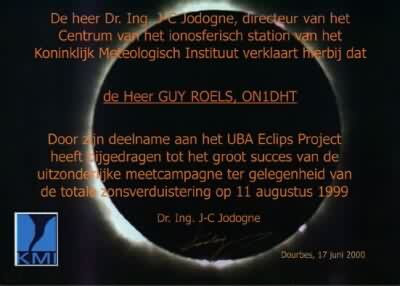
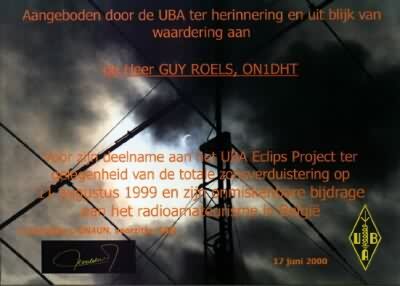
More
here:
![]()
[home]
.
[mail] [shack] [homebrew]
[software] [satellite]
[haminfo] [mods] [hamexams]
[on6jun] [links]